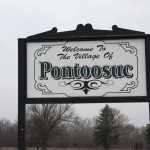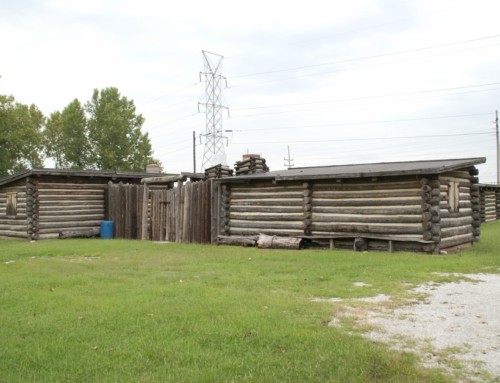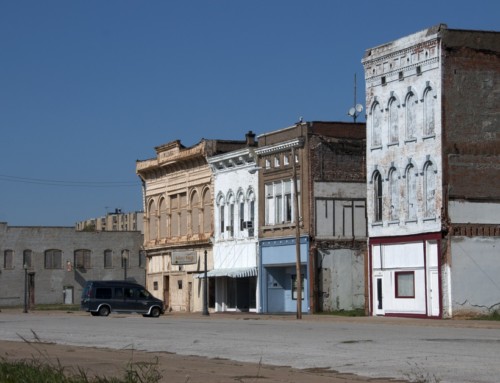History
Pontoosuc peaked early. Kentucky-born Hezekiah Spillman moved in and built a home around 1825. He made a living by selling wood to passing steamboats, so this spot naturally became known as Spillman’s Landing. He also ran a ferry across the river; here are some sample fees:
- $1 for a man and horse;
- 0.50 cents for a man on foot;
- $3 for a wagon and team;
- 0.25 cents for each horse or cow;
- 0.125 cents for each sheep, hog, or goat.
Most of the early residents were from the eastern US, Massachusetts, especially. When the village was platted in 1836, they wanted to name it after the town many of them came from, but Pittsfield was already being used in southern Illinois, so they went with Pontoosuc, which is a lake near Pittsfield, Massachusetts.
The village had good river access, even when it wasn’t part of the river. Lying in a low spot next to the river made for regular inundations and, in the 19th century, illness, which explains part of the reason why Pontoosuc never became a big city. Much of the original town site was submerged in the 1910s when the Keokuk dam was completed. Pontoosuc never had much industry, anyway, except for a few fishermen and a seasonal poultry packing business.
Pontoosuc still isn’t separated from the river by a levee, so the village has gotten wet many times. The 2008 flood was one of the most severe, wiping out part of the village. Pontoosuc today has many houses that are in rough shape or abandoned.
Pontoosuc’s greatest claim to fame is probably the role many of its residents played in the conflict with Mormons at Nauvoo. In 1842, thirty local men organized a militia called the Pontoosuc Independent Military Company under the command of George Buchanan, a group that eventually peaked at about 100 members. To the Mormons in the area, they were the “Bloody Pontoosucans”, dangerous vigilantes who attacked Mormons without cause. The Pontoosucans, though, insisted that they were just protecting their families and property from what they believed was a lawlessness that arrived with the large numbers of Mormons who moved into the area.
Any man could join the Pontoosuc militia, but he had to supply his own weapon and had to be ready to drop everything and respond to emergencies. The Pontoosuc Independent Military Company coordinated with similar groups in Carthage and Warsaw; they claimed some success chasing down suspected thieves and recovering a few stolen items.
Later in life, many of those who had been in the militia stuck to their guns that their opposition had nothing to do with religion, even though many also said they were deeply disturbed by some of the stories from Nauvoo, particularly the ones about polygamy. Instead, the veterans of the militia insisted that the conflict was entirely due to the crimes that they believed were committed by some Mormons and the lack of accountability for those crimes. Over the years, people from Pontoosuc and other areas related stories of non-Mormons who initially helped out Mormons in need only to be robbed by them later.
Captain James Duffy Logan was one of those who insisted the whole struggle had nothing to do with religion. In a 1902 interview published in the Dallas City Review, he said:
…the original excuse advanced for the bringing into existence of the Pontoosuc Company was mutual protection against thievery and roving bands of Mormons who took most of what they wanted by order of the Lord, and in numerous instances had intimidated women and claimed they were acting under their chief prophet, Joseph, who told them (so they said) to take the property from the Gentiles in the name of the Lord….Do I have any conscientious regrets for the part that was enacted by myself and by my orders in expelling the Mormons from our land? No. No…I have no regrets, no apologies. Neither do I believe that the 105 men who were with me in the final overthrow lost any sleep over their part enacted by them. I wish it had been in me to accomplish more. In fact there was a reign of terror. It was a struggle for mastery. They had a narrow-minded bigot as prophet and lieutenant general. They had unprincipled leaders who were strictly obeyed to the letter. They were armed in part by the State of Illinois. In fact being 20,000 strong in and out of Nauvoo throughout the county during 1844, they called all before them and they or us had to go—one or the other must go down.
It’s hard to tell from the vantage point of the 21st century whether these accounts might have been based on a few events that were retold repeatedly and that incited an irrational fear or whether these incidents were, in fact, widespread. Regardless, though, it seems clear that the Pontoosucans believed they were fighting lawlessness and not the Mormon faith.
**Looking for more places to visit along the Mississippi River? Check out Road Tripping Along the Great River Road, Vol. 1. Click the link above for more. Disclosure: This website may be compensated for linking to other sites or for sales of products we link to.
Where to Go Next
Heading upriver? Check out Dallas City.
Heading downriver? Check out Niota.
Community-supported writing
If you like the content at the Mississippi Valley Traveler, please consider showing your support by making a one-time contribution or by subscribing through Patreon. Book sales don’t fully cover my costs, and I don’t have deep corporate pockets bankrolling my work. I’m a freelance writer bringing you stories about life along the Mississippi River. I need your help to keep this going. Every dollar you contribute makes it possible for me to continue sharing stories about America’s Greatest River!
©Dean Klinkenberg, 2024, 2021, 2018,2013,2011






